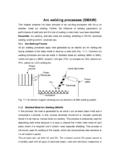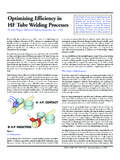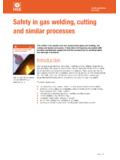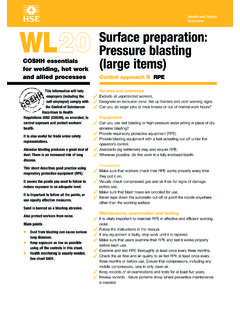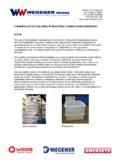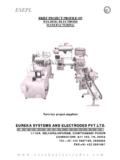Transcription of WELDING FUME AND GAS EXPOSURE
1 WELDING fume AND GAS EXPOSURE . By Jerome E. Spear, CSP, CIH. A recent $1 million award by an Illinois jury to like symptoms), to long-term lung damage and/or a welder was the first plaintiff victory in a WELDING neurological disorders, such as lung cancer rod failure-to-warn suit and many similar cases and/or Parkinson's disease. Figure 1 includes are expected to follow. In the case of Elam v. AO the most common WELDING fume constituents and Smith et. al., the jury concluded that the their associated health effects. manganese in WELDING fumes caused a 65-year Gases are also old worker to develop a neurological disorder generated from similar to Parkinson's disease ( , Manganism). WELDING , which may Since there are more than 500,000 workers include carbon employed in WELDING and related occupations in monoxide, ozone, the (Bureau of Labor Statistics) and another and nitrogen oxides.
2 200,000 welders or more who are retired, there is Carbon monoxide a potential pool of more 700,000 who are (or (CO) is an odorless, previously have) been exposed to WELDING fumes colorless gas that on a daily basis. may be formed by WELDING produces various contaminants at a the incomplete sufficient rate to cause both short and long-term combustion of the health effects if not properly controlled. A electrode covering or comprehensive review (Antonini) of epidemiological studies of welders indicates that flux and by the use of carbon dioxide (CO2) as a a large number of welders experience some type shielding gas. Overexposure to CO inhibits the of respiratory illness (such as bronchitis, airway body's red blood cells to sufficiently carry oxygen irritation, lung function changes, and a possible to other tissues within the body, which increase in the incidence of lung cancer).
3 Subsequently results in asphyxiation. WELDING Pulmonary infections may also increase in terms does not normally generate CO at high enough of severity, duration, and frequency among levels to be a concern; however, high levels of welders following EXPOSURE to WELDING while carbon monoxide may potentially accumulate studies have also associated chronic EXPOSURE to when WELDING or air arc gouging in confined manganese with a risk for Parkinson's disease. spaces. There is also a potential of an oxygen- deficient atmosphere if WELDING inside of a The best way to mitigate the potential of confined or enclosed space if an inert gas (such large settlements is to provide documented as argon) is used as the shielding gas. evidence that you have progressively made efforts in controlling EXPOSURE to WELDING fumes Ozone, nitrogen dioxide and nitric oxide are and gases.
4 The first step is to understand the produced by the interaction of ultraviolet light potential health effects and recognize the factors (from the WELDING arc) with the surrounding air. that affect a welder's potential EXPOSURE to These compounds are irritating to the eyes, nose WELDING fumes and gases. and throat. High exposures can also cause fluid in the lungs and other long-term pulmonary Health Effects illnesses. WELDING fumes are very small particles that If the metal has been degreased with a are formed when the vaporized metal rapidly chlorinated solvent, other airborne gases (such condenses in air and are typically too small to be as phosgene, hydrogen chloride, chlorine gas, seen by the naked eye, but collectively, form a etc.)
5 May be produced. These gases generally visible plume. The health effects associated with cause irritation to the eyes, nose and respiratory metal fumes depend on the specific metals system and symptoms may be delayed. present in the fumes but may range from short- term illnesses, such as metal fume fever ( , flu- 1. 2004 Spear Consulting, LLC. Figure 1 Common Constituents in WELDING Fumes Metal Common Source(s) Health Effect(s). Constituent Aluminum Component of some alloys (such as Inconel , copper, zinc, Lung damage, irritation steel, copper, zinc, steel, magnesium, brass, and filler materials). Beryllium Hardening agent found in copper, magnesium, and aluminum Cancer (lung), berylliosis alloys. Cadmium May be contained in plated materials and/or zinc alloys and Kidney damage sometimes used in the manufacture of fluxes in flux-cored electrodes.)
6 Chromium Contained in most stainless steel and high-alloy materials. Also Irritation, dermatitis, liver, kidney, respiratory, used as plating material. cancer (hexavalent chromium insoluble compounds). Copper Included in alloys such as Monel , brass, bronze. Irritation, damage to the gastrointestinal tract, metal fume fever Fluorides Common ingredient in electrode coatings and flux material for Irritation, bone damage, fluorosis both low- and high-alloy steels. Iron The major contaminant in all steel- WELDING processes. Siderosis ( , pigmentation of the lungs). Lead Common in solder, brass and bronze alloys. May also be Central nervous system, blood, kidney, contained in the primer/coating on steels. reproductive Magnesium Found in light metal alloys.
7 Irritation, metal fume fever Manganese Contained in most WELDING processes. Central nervous system, lung damage, reproductive Molybdenum Contained in some steel alloys, stainless steel, and nickel alloys. Irritation, lung damage, central nervous system Nickel Contained in stainless steel, Inconel , Monel , Hastelloy and Dermatitis, pneumoconiosis, central nervous other high-alloy materials, WELDING rods, and plated steel. system, cancer, lung damage Silicon Present in most WELDING consumables. Irritation, fever Tin Used in some solder alloys and bronzes. Stannosis ( , benign lung disease), central nervous system, irritation, immunotoxicity Titanium Common ingredient in many flux-cored electrodes and in the Lung damage coating of covered electrodes.
8 Vanadium May be contained in some steel alloys, stainless steel, and nickel Irritation, lung damage alloys. Zinc Common component of galvanized and coated metal. Metal fume fever (ACGIH, Antonini). Common WELDING Processes and levels of metal fume and fluoride EXPOSURE ;. however, stick WELDING is considered to have little fume Generation Rates potential for generating ozone, nitric oxide and The type of WELDING process is directly nitrogen dioxide. related to the amount of fumes and gases that Gas Metal Arc WELDING (GMAW) or are generated. Therefore, it is important to have metal inert gas (MIG) WELDING is typically used for a basic understanding of the WELDING process in most types of metal and is faster than SMAW. order to assess the risk of EXPOSURE .
9 This process involves the flow of an electric arc Shielded Metal Arc WELDING (SMAW, between the base metal and a continuously stick WELDING ) is commonly used for carbon spool-fed consumable electrode. Shielding gas steel WELDING and low alloy WELDING . In SMAW, is supplied externally; hence, the electrode the electrode is held manually, and the electric typically has no flux coating or core. Although arc flows between the electrode and the base GMAW requires a higher electrical current than metal. The electrode is covered with a flux SMAW, GMAW produces fewer fumes since the material, which provides a shielding gas for the electrode has no fluxing agents. However, due to weld to help minimize impurities. The electrode the intense current levels, GMAW produces is consumed in the process, and the filler metal significant levels of ozone and nitrogen oxides.
10 Contributes to the weld. SMAW can produce high 2. 2004 Spear Consulting, LLC. Flux Core Arc WELDING (FCAW) is used In addition to the WELDING technique, studies for carbon steels, low alloy steels and stainless have shown that the fume generation rate is also steels. This WELDING process has similarities to influenced by the following factors: both SMAW and GMAW. The consumable Electrical current: In general, the fume electrode is continuously fed from a spool and an generation rate is exponentially proportional electric arc flows between the electrode and base to the current. metal. The electrode wire has a central core containing fluxing agents and additional shielding Arc voltage: The fume generation rate gas may be supplied externally.

